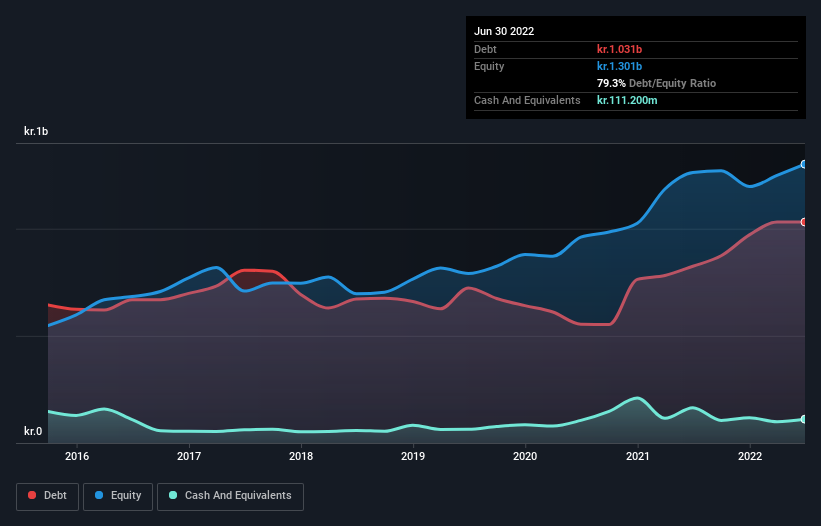These 4 Measures Indicate That Brødrene Hartmann (CPH:HART) Is Using Debt Extensively
Warren Buffett famously said, 'Volatility is far from synonymous with risk.' When we think about how risky a company is, we always like to look at its use of debt, since debt overload can lead to ruin. Importantly, Brødrene Hartmann A/S (CPH:HART) does carry debt. But the more important question is: how much risk is that debt creating?
Why Does Debt Bring Risk?
Debt assists a business until the business has trouble paying it off, either with new capital or with free cash flow. If things get really bad, the lenders can take control of the business. While that is not too common, we often do see indebted companies permanently diluting shareholders because lenders force them to raise capital at a distressed price. Of course, debt can be an important tool in businesses, particularly capital heavy businesses. The first step when considering a company's debt levels is to consider its cash and debt together.
Check out our latest analysis for Brødrene Hartmann
What Is Brødrene Hartmann's Debt?
The image below, which you can click on for greater detail, shows that at June 2022 Brødrene Hartmann had debt of kr.1.03b, up from kr.824.9m in one year. However, it also had kr.111.2m in cash, and so its net debt is kr.920.1m.

How Healthy Is Brødrene Hartmann's Balance Sheet?
According to the last reported balance sheet, Brødrene Hartmann had liabilities of kr.675.8m due within 12 months, and liabilities of kr.1.01b due beyond 12 months. Offsetting this, it had kr.111.2m in cash and kr.583.2m in receivables that were due within 12 months. So it has liabilities totalling kr.991.9m more than its cash and near-term receivables, combined.
This deficit isn't so bad because Brødrene Hartmann is worth kr.1.80b, and thus could probably raise enough capital to shore up its balance sheet, if the need arose. But it's clear that we should definitely closely examine whether it can manage its debt without dilution.
We measure a company's debt load relative to its earnings power by looking at its net debt divided by its earnings before interest, tax, depreciation, and amortization (EBITDA) and by calculating how easily its earnings before interest and tax (EBIT) cover its interest expense (interest cover). This way, we consider both the absolute quantum of the debt, as well as the interest rates paid on it.
While Brødrene Hartmann's debt to EBITDA ratio (4.0) suggests that it uses some debt, its interest cover is very weak, at 2.3, suggesting high leverage. It seems that the business incurs large depreciation and amortisation charges, so maybe its debt load is heavier than it would first appear, since EBITDA is arguably a generous measure of earnings. So shareholders should probably be aware that interest expenses appear to have really impacted the business lately. Even worse, Brødrene Hartmann saw its EBIT tank 85% over the last 12 months. If earnings keep going like that over the long term, it has a snowball's chance in hell of paying off that debt. There's no doubt that we learn most about debt from the balance sheet. But ultimately the future profitability of the business will decide if Brødrene Hartmann can strengthen its balance sheet over time. So if you're focused on the future you can check out this free report showing analyst profit forecasts.
But our final consideration is also important, because a company cannot pay debt with paper profits; it needs cold hard cash. So the logical step is to look at the proportion of that EBIT that is matched by actual free cash flow. Over the last three years, Brødrene Hartmann reported free cash flow worth 5.7% of its EBIT, which is really quite low. For us, cash conversion that low sparks a little paranoia about is ability to extinguish debt.
Our View
Mulling over Brødrene Hartmann's attempt at (not) growing its EBIT, we're certainly not enthusiastic. But at least its level of total liabilities is not so bad. Overall, it seems to us that Brødrene Hartmann's balance sheet is really quite a risk to the business. So we're almost as wary of this stock as a hungry kitten is about falling into its owner's fish pond: once bitten, twice shy, as they say. When analysing debt levels, the balance sheet is the obvious place to start. But ultimately, every company can contain risks that exist outside of the balance sheet. For example - Brødrene Hartmann has 1 warning sign we think you should be aware of.
When all is said and done, sometimes its easier to focus on companies that don't even need debt. Readers can access a list of growth stocks with zero net debt 100% free, right now.
Valuation is complex, but we're here to simplify it.
Discover if Brødrene Hartmann might be undervalued or overvalued with our detailed analysis, featuring fair value estimates, potential risks, dividends, insider trades, and its financial condition.
Access Free AnalysisHave feedback on this article? Concerned about the content? Get in touch with us directly. Alternatively, email editorial-team (at) simplywallst.com.
This article by Simply Wall St is general in nature. We provide commentary based on historical data and analyst forecasts only using an unbiased methodology and our articles are not intended to be financial advice. It does not constitute a recommendation to buy or sell any stock, and does not take account of your objectives, or your financial situation. We aim to bring you long-term focused analysis driven by fundamental data. Note that our analysis may not factor in the latest price-sensitive company announcements or qualitative material. Simply Wall St has no position in any stocks mentioned.
About CPSE:HART
Brødrene Hartmann
Brødrene Hartmann A/S produces and sells moulded-fibre packaging for eggs and fruits in Denmark, rest of Europe, North and South America, India, and internationally.
Adequate balance sheet and fair value.
Market Insights
Community Narratives



